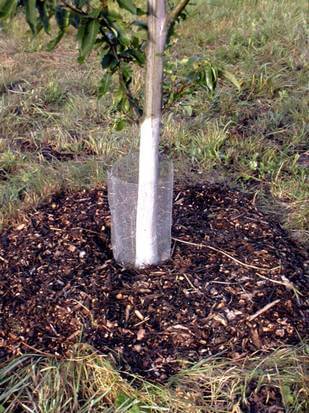Trees, shrubs and vines may need a little help getting ready for winter’s frigid temperatures, but not too much.
Don’t prune, don’t fertilize, don’t water. Any of those three could awaken parts of the plants at a time when they should be shutting down.
Of course, there are exceptions to this do-nothing approach. Late-season watering is called for only if winter survival is chancy because a plant is crying out from thirst. Evergreens, especially young ones, are an exception to the no-watering rule because they have limited root systems and lose water through their leaves all winter, so they need watering during extended periods of dry weather.
Winter hazards
One potential winter hazard is sunscald, which can occur when the temperature of dark-colored bark that’s been heated by sunlight on a clear day plummets at sunset. Sunscald, which is more of a problem with thin-barked trees, can be avoided with diluted white latex paint. Mixed with equal parts water, and either sprayed or painted onto tree trunks, the white latex paint reflects sunlight to keep the bark evenly cold.
An organic mulch such as wood chips, straw, leaves or pine needles spread at the foot of a tree, shrub or vine is another way to help woody plants in winter. Fluffy, organic mulches insulate the soil, preventing the frequent freezing and thawing that could heave young plants, still not well-anchored in the soil, up and out of the ground.
Although stems won’t grow until winter is over, roots grow whenever soil temperatures are above about 40 F. Insulation provided by mulches also prevents deep freezing of the soil so roots have a longer period of growth and can continue to absorb water from the ground. Evergreens, especially, benefit from this insulating blanket that keeps water from freezing. The sooner that organic mulches are in place, the sooner warmth in the ground can be retained.
Furry creatures
On the downside, mulches provide mice with a cozy haven, hidden from the eyes of predators. And hungry mice can eat and damage your plants. Don’t give them the convenient food, lodging and protection of mulch; leave a mulch-free ring of a few inches diameter around the base of the plant.
For further protection against mice and, a little higher up, rabbits, the well-accoutered woody tree or vine will also wear something around its “ankles” for winter: A cylinder of 1/4-inch mesh hardware cloth, 2 feet high and pressed an inch into the soil to discourage burrowing, keeps these creatures at bay.
Make the cylinder’s diameter wide enough to allow for plant growth, and to let you reach inside to pull weeds. Alternative “anklets” might include tree wrap paper, white plastic spirals (which protect against sunscald as well as rodents), and various other plastic, metal or plastic-coated metal guards. Remove any of these materials, except for the hardware cloth, in spring, or they will provide bark-eating insects safe haven from birds.
Your woody plants’ final winter accessory is some sort of scent to keep deer at bay. A number of repellents are commercially available, some offering a one-two punch of olfactory and taste turnoffs. Alternatively, create your own repellent by, for example, hanging a cut bar of deodorant soap (leave the wrapper on for better longevity) on each plant, or by blending water with eggs, for aroma, and hot pepper, for taste, and then spraying the mixture on your plants.
Electronic repellents (such as Deerchaser) can supplement these “perfumes” to keep deer at a distance.
For best results, perfume woody plants before deer begin feeding and then reapply the repellent, preferably a different one each time, every few weeks until spring.
Read more of our blog here
Original post here

